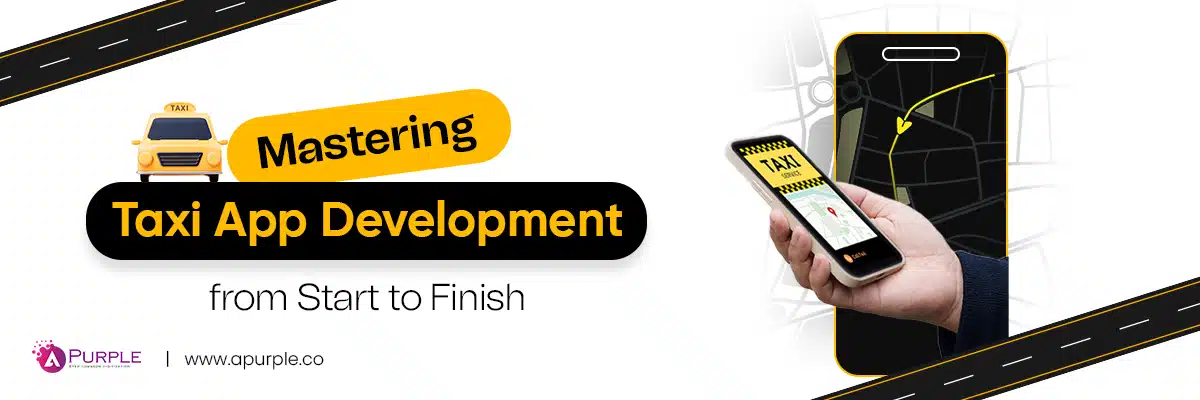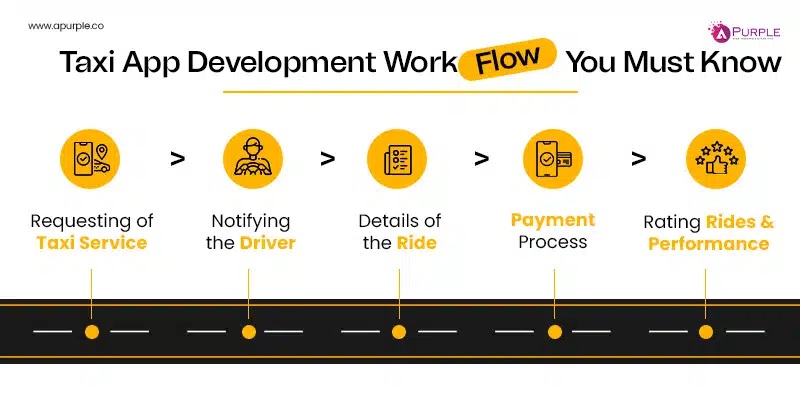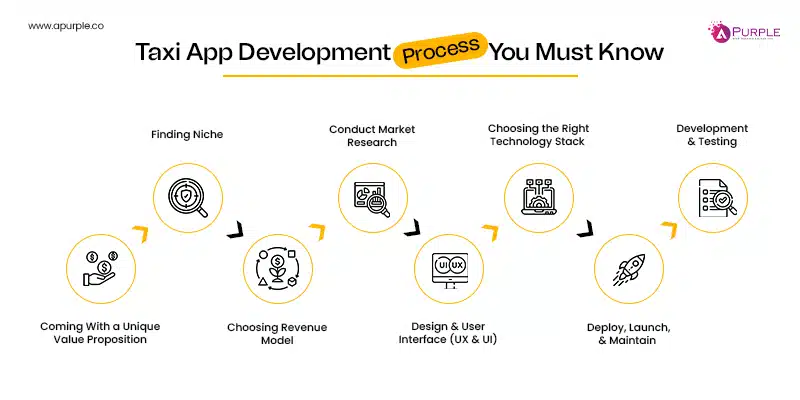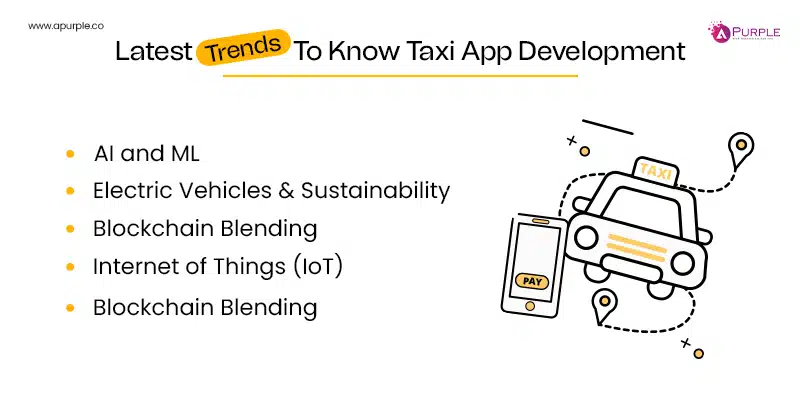
Summary:
This blog encompasses every essential aspect of taxi app development, ranging from insightful statistics to how aPurple can seamlessly assist you in crafting your taxi app. We’ve curated the finest information tailored to your needs, ensuring a comprehensive guide for your journey in taxi app development.
You cannot deny the fact that taxi apps have surpassed traditional taxi services. The online taxi booking system has brought significant comfort for people while travelling.
Amidst this transformative shift, a burning question arises: What’s the outlook for new entrants in the taxi app industry?
Our resounding answer: Absolutely! Despite the dominance of established taxi application giants like Uber and Lyft, there’s ample room for fresh innovations in the taxi industry.
And thus, we present this comprehensive guide—a roadmap to taxi app development from inception to fruition.
However, before beginning our ride on the taxi booking app development, let’s first have a glance at what’s going on in the taxi industry.
Taxi Industry Market Statistics – Worldwide
The global taxi industry market is valued at billions of dollars, with projections for continued growth in the coming years. Key drivers include increasing urbanization, rising disposable incomes, and advancements in technology driving the adoption of ride-hailing services.
And season it only with just the right strategy you can to succeed with speed. So, let’s turn on the ignition and start our ride.
How Does a Taxi Booking App Work?
Any taxi booking app works on one core principle – connecting riders and drivers. It acts as a bridge and connects people looking for cabs or taxis to those who looking to provide the service. Here is a simple process of a taxi booking app on a normal day:
However, when it comes to creating a taxi business around it, complexities arrive. Several different features come into the picture to outplay competitors and win the overall market. These features are all meticulously integrated during the taxi app development process
But before we delve into these features, it is important to look at different types of taxi apps that go through taxi booking app development.
Different Types of Taxi Apps
The landscape of taxi apps has exploded far beyond the simple concept of hailing a ride from your phone. And if we look, this is indeed required. Today, you can try offering to diverse needs and lifestyles.
So, if you are looking to go beyond the traditional Uber model, then here’s a glimpse into 15 of the most popular categories that you can explore:
Core Transportation
Know more – Uber vs Lyft
Specialized Services
Business and Enterprise
Beyond Passengers
Accessibility and Inclusion
Niche Markets
The following types of taxi apps merely scratch the surface. There are apps for on-demand shuttles, long-distance travel, multi-modal transportation (combining taxis with buses, trains, etc.), and even eco-friendly options focusing on electric vehicles.
The future taxi mobile app market holds even more possibilities, with concepts like subscription-based rides, language translation features, and integration with real-time traffic data to optimize routes. From adventure travel to remote work commutes, the world of taxi apps is immense and evolving.
Read More to Know More – On-demand car rental service
Now, you might want to know more about taxi app development like its process feature, cost, process, monetization methods, and more.
Great! But before this, it is important to learn about the vital features to include during the on-demand taxi app development.
Features to Include in Taxi Booking App
Each taxi booking app offers a different set of features that are selected based on the decisions made during the planning phase of the taxi app development. However, there are certain features that make an app called a taxi booking app.
The first thing to be aware of is that a taxi booking app development company develops different apps for three different groups:
Different taxi app solutions for taxi business startups, entrepreneurs, traditional taxi service owners, and more.
Here are some basic features that each cab booking App Company must try integrating into their apps:
Basic Features of A Taxi Booking App |
||
|---|---|---|
| Driver | Rider | Admin |
| Easy registration with social media login | Easy Registration with social media logins | Secure login to manage the database |
| Proper driver verification | A user profile for each rider including history, rating, and behaviour | Driver and passenger management |
| Driver’s profile with pay rate, ratings, past bookings, etc. | Taxi booking interface | Fleet management |
| Availability status that the driver can turn off and on | Simple fare calculations to get an estimate | Review ad rating system management |
| Nearby riders with their pickup location and destination | Driver ratings, estimated time of arrival (ETA), and tracking | Customer query handling |
| Push notifications for nearby rides | Past payments and bookings for support and complaint purposes | System content management |
| Ride acceptance and cancellation | Emergency button | FAQs |
It is always best to keep your taxi booking app development team and the business management team in the loop to work on these taxi mobile app features.
Now, as your taxi app development company advances in the field, it looks to elevate its game. This means adding advanced features to the taxi booking app.
Here are some advanced features that a company might think of including in the taxi app software.
Advanced Features of a Taxi Booking App |
|||
|---|---|---|---|
| Feature | Drivers | Riders | Admin |
| In-App Navigation | Get turn-by-turn directions | See the driver’s estimated arrival time (ETA) | Track driver location and ride progress |
| Multi-stop Bookings | Accept rides with multiple destinations | Plan trips with waypoints | Manage multi-stop bookings efficiently |
| Fare Estimates | View estimated fares before accepting a ride | See upfront pricing for the trip | Set fare calculation methods and manage surge pricing |
| In-App Chat | Communicate with riders directly | Text drivers with questions or requests | Monitor driver-rider communication |
| Cashless Payments | Accept cashless payments (credit card, wallet) | Pay for rides securely within the app | Manage payment processing and settlements |
| Ride History & Ratings | View past trips and earnings | Rate and review drivers | Analyze driver performance and rider feedback |
| Advanced Scheduling | Schedule rides for later times | Book rides in advance with guaranteed availability | Manage scheduled rides and dispatch drivers efficiently |
| Driver Verification | Background checks and license verification | View driver information and ratings | Ensure driver safety and quality |
| In-App Promotions & Bonuses | Receive bonuses for completing rides or exceeding targets | View and claim promotional offers | Create and manage promotions to attract drivers and riders |
| Route Optimization | Receive optimized routes based on traffic conditions | See the most efficient route for the trip | Improve driver efficiency and reduce ride times |
| Emergency Button | Access emergency assistance with one tap | Report safety issues or request help | Monitor emergencies and dispatch assistance when needed |
| Vehicle Categorization | Choose vehicle type based on size, amenities (AC, pet-friendly) | Filter rides by preferred vehicle type | Manage vehicle options and pricing for different categories |
| Multi-lingual Support | Access app interface and support in multiple languages | Communicate with drivers who speak different languages | Enable a broader user base and improve accessibility |
Know that these on-demand taxi booking app features are not the limit here. The list goes as far as the business mind goes.
Deciding what features to include is a part of the business planning phase. And because a cab booking business mainly lives in the digital realm, it always gets aligned with the taxi app development phases.
Taxi Booking App Development Process [ Step-by-Step Guide ]
Taxi app development can be an exciting venture. However, it requires careful planning and execution. Here’s a breakdown of the key steps involved:
1. Coming With a Unique Value Proposition
As we saw, the taxi app market is although a potential ground, it is competitive as well. To counter this competitiveness, you must come up with a unique value proposition. This will tell your target user base why they must choose you over those already hailing in the industry.
Here are a few examples of how you can offer better features over other taxi apps:
Unique value to riders:
Go beyond the basics of ride-hailing. By providing seamless access to transportation at their fingertips, your taxi app will enhance the travel experience of the riders. You can offer features like:
Unique value to drivers:
Here, try to prioritize the driver’s well-being and earnings potential. Offer values such as:
This step in the taxi app development process is all about offering something better to the users. Your taxi booking app development company can guide you better in this regarding the latest technology available in the market and how it could be used.
2. Finding Niche
Finding the niche is a crucial aspect of any business development strategy. It decides what features to offer, what strategies to make, and what revenue model to include.
Here are a few strategies that you might include in this phase:
Always clearly mention your market niche to your taxi booking app development company. It will help them create unique development strategies for concept building, UI/UX designs, app development and more,
3. Choosing Revenue Model
Developing a captivating taxi app is one step in the journey. The real test lies in creating a sustainable revenue stream. Here’s a breakdown of popular monetization models for taxi apps to consider:
| Revenue Model | What It Is |
|---|---|
| Freemium Model |
This model works like a strategic hook for growth. In this model, a taxi booking app may offer features like ride booking, tracking, and other basic features in the free version. In the premium version, try offering premium features such as priority booking, advanced route options, in-app entertainment, etc. The better your features, the more people will upgrade. |
| In-app Ads |
This model rather focuses on the advertisement. An app may easily integrate targeted advertisements from relevant businesses within the app. For example, it may show nearby restaurants near the destination or mid-way. Ensure proper user interface during the taxi app development to support this model. Another way is to earn through commission. Earn income based on ad impressions, clicks, or user actions within the ad. This model can be a good secondary revenue stream. |
| App Subscriptions |
This model might seem like the Freemium model, but it is a bit different. In this model, a taxi booking app may offer different tiers of subscription plans with varying benefits.
It’s great to foster user loyalty. |
| Online Commission | Here, drivers will share the profit on every ride. This can offer a straightforward revenue generation where a company can charge a fixed commission on each ride completed. |
| Multi-Pronged Approach |
Here, a taxi booking app can combine an online commission on every ride with a flat platform fee for bookings. This offers a safety net if ride volumes fluctuate. But, because each entity has different needs, you can set separate commission rates for drivers and passengers. |
These are some of the common business models hovering around in the market. You may have a unique business model fuelled with creativity and market knowledge. Your taxi app development company can help you the best to get uniqueness for your app.
Also, when getting taxi booking app development done, ensure certain areas such as cancellation fees, fines, or any other revenue-generating customized feature.
4. Conduct Market Research
Once you have decided what you want to offer with your taxi mobile application, it is time to do thorough market research. Many companies combine this taxi booking app development step with the previous steps to carve a foolproof business model, while others keep them different.
Now, before you go for the taxi app development, make sure you’ve done your research on these aspects:
These are just a few facets of market research for developing taxi apps. Based on your business idea and needs, you can go even deeper and further.
5. Design and User Interface (UX and UI)
At this point, the work of your taxi app development company starts. A business idea is all good, but to make it a success, it must be transformed into a smooth and flawless taxi mobile application.
There are two areas that can foretell the success of an app:
Ensure that your taxi app development company serves you with the best taxi booking app design possible in your given budget. It must be user-friendly and have an intuitive interface that simplifies navigation and booking processes for both riders and drivers. Not only this. But a taxi booking app must be visually appealing as well
6. Choosing the Right Technology Stack
If you are already a web developer and know some basic coding, you might be aware of this. However, if you are not aware of web and app development, then don’t worry! The “technology stack” is basically the toolbox you’ll use to build your app. It includes things like
Now, this tech stack changes with the change in the platform you are developing the taxi booking app for.
Although your taxi booking app development company will take away your worries, here is a brief overview to give you an idea:
Now, although you might not need these all at once in the taxi booking app development process, having these tips can save you errors. To err might be human, but not when it comes to web and app development. It might cost you the whole business idea.
7. Development and Testing
Now, it is time to implement the app’s ideas into a high-quality and functional taxi app. At this point, most work will be handled by the taxi app development company. But don’t sit relaxed. Always stay in the loop with the mobile app development agency to ensure smooth development and outcome.
It is best to consider using agile development methodologies for iterative development, testing, and feedback loops. But the work doesn’t end with development.
Unit testing of the app on various devices and operating systems to ensure functionality and identify bugs. This taxi app development process might save you from initial pitfalls in your strategic run.
8. Deploy, Launch, and Maintain
Once you and your taxi booking app development company are relaxed about the app being flawless and bug-free, it is time to launch it in the relevant app stores.
If you want to see it succeed here, work on these two things:
Once the app is launched, keep an eye on the feedback and resolve the issues with regular updates. Continuously update your app with bug fixes, new features, and security enhancements. Your taxi app development company will stay in a continuous loop here.
Tip – Actively collect user feedback and iterate on your app based on user needs and market trends.
These were some of the main steps involved in the taxi app development process.
Now, because on-demand taxi app development is a time-consuming process, and because the taxi booking app development cost might be high for many small startups, a solution comes in the name of a white-label app.
What is a White-Label/Ready-made/Off-the-Shelf Taxi Booking Solution?
Simply put, a white-label or ready-made app is a quick solution that comes in the form of cloning. It’s kinda like… a pre-made mix, you see? For example, an Uber clone.
The white-label app contains a prebuilt taxi app template that contains almost all features and designs. It’s cloning the app and then customizing it for specific business needs. The benefits of this type of taxi app clone are many:
All your taxi booking app development company needs to do is add your company’s logo, some unique features, and the brand color schemes. And here you are, ready with a full-fledged functional app.
But, there might be cases where a taxi app software might need fresh development. What it might cost?
How Much Does it Cost to Build a Taxi App?
The cost of building an Uber-like taxi app can vary based on several factors such as
And much more.
The development cost of taxi app development can range between $10,000 and $170,000 for one platform (iOS or Android) and may go above this range depending on the specific project requirements.
On average, a basic taxi booking application with essential features may cost around $40,000 to $50,000. And the development time for such an app? Anywhere between 3 and 4 months with a team of six professionals and approximately 1200-1500 hours of work.
Trends In Taxi Applications Development
Globalization and the pace of technology have left nothing without their impact. And so is the taxi app development market. It is constantly evolving. Not harnessing the potential around might push you to the back foot in the market.
Here’s a peek at some of the hottest trends shaping the future of taxi apps:
AI and ML
Artificial Intelligence and Machine learning are already around. Now, it all comes down to blending their potential in the on-demand taxi development. How?
And the list goes on. This way you can adjust the prices for your rider and provide a better user experience.
Electric Vehicles and Sustainability
Times are changing and so are the concerns regarding the falling climate. Numerous companies are now aligning with the law by being sustainable and eco-friendly. As a taxi booking app company, you might want to offer electric vehicles for eco-conscious riders demanding greener transportation solutions
You may also integrate a feature of EVs in the fleet during taxi app development. This way, riders will have plenty of options to book from.
Internet of Things (IoT)
Now, most digital devices are gradually connecting to the internet. This means tons of data that can be used and managed in a better way. Now, IoT in taxi booking software can work in several ways.
Here is a simple example – collaborate with Spotify and let your riders sync their playlists with the cabs. Isn’t this super cool?
All this adds to security and a better experience.
Blockchain Blending
taxi booking apps have their perks, but there’s always room for improvement. Blockchain, a super secure tech, can shake hands with the taxi app during the taxi booking app development. It can offer more such as:
Still confused? Here is how it might work:
Why Choose aPurple for your Taxi App Development?
Building a taxi app is a marathon, not a sprint. And here, aPurple can be your guide as well as your partner as an experienced taxi app development company. It will not only anticipate roadblocks but will offer exceptional taxi app development. Here is why –
So, if you are looking to make an app like Uber? aPurple can provide you with the required boost and expertise. Let’s turn your taxi app vision into reality. Contact us today for a free consultation.
The Bottom Line
The taxi app market is booming with still more room for new players. However, as there is competition, new companies must look to offer some unique value proposition. By following these steps and considering the latest trends, you can develop a successful taxi booking app. How?
By defining your niche, choosing features, building the app or hiring the best taxi app development company, testing rigorously, and launching with a marketing strategy.
Find it tough? Partnering with an experienced taxi app development company like aPurple can help you feel at ease. aPurple can streamline the process and increase your chances of success. Whether you’re looking to build an Uber app clone or something more specialized, the future of taxi apps is bright.
So, turn on the ignition and get started on your ride to app development success!
FAQS:
Taxi app development can cost anywhere from $10,000 to $170,000. The final cost depends on features, complexity, and the developer’s location.
Building a taxi app involves several steps starting from defining a niche market, then designing the app’s UI, developing features like booking and payment, rigorously testing, launching, and regularly updating.
Taxi booking apps connect riders and drivers through a mobile app. Using this app, riders search for nearby drivers, book rides, and pay, while drivers accept rides and receive fares directly through the app.
Although the taxi app market is still generating revenue, profit potential depends on the business idea and strategies involved.
Choosing a development company depends on your needs and budget. If you are looking for an experienced taxi booking app development company, aPurple can offer flexible solutions.






